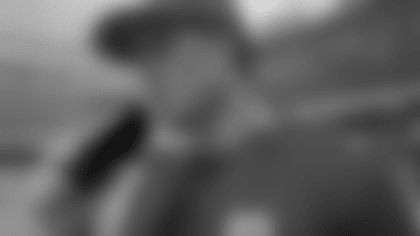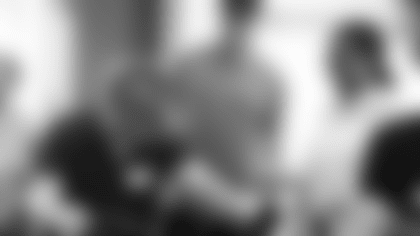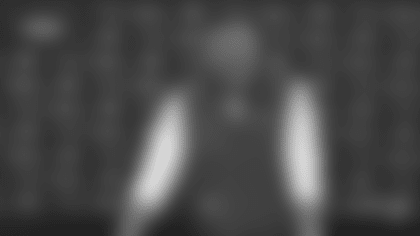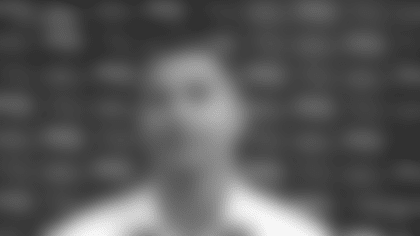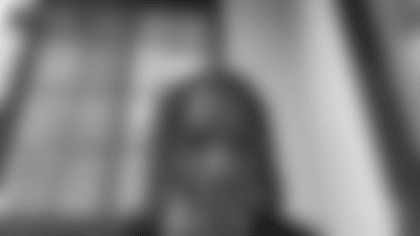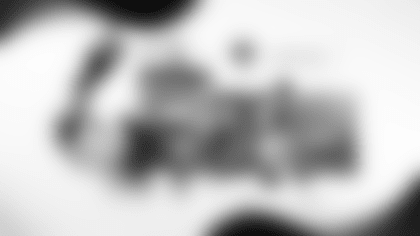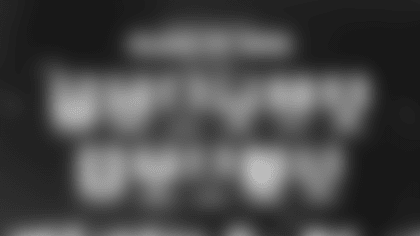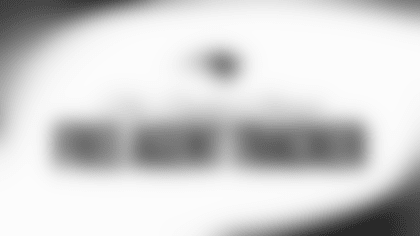Q: Brandon LaFell was talking yesterday about how when you watch film of opponents, you never show any bad plays. Can you describe your thinking when it comes to only showing plays that you think can hurt you?
BB: Well, I wouldn't agree with that statement. You should ask Brandon LaFell if I've ever shown any of our opponents missing a tackle. Just ask him that. We show plays that are relevant, whatever they are. There are good plays. There are things that we think we can take advantage of. Whoever we play, each team has strengths and weaknesses. Each player has strengths and weaknesses. We try to identify those and give examples of how they could come up in the game or will come up in the game. Some of them are absolutely going to come up. Other things are situational and maybe they'll happen or maybe they won't, but you have to be prepared for them.
Q: Along those lines, the purpose of showing film is to show what you can do successfully, not so much what they do, right?
BB: No, I think, look, you've got to stop the other team's strengths. I don't think you want to let another team that does something well just do that. You take the strength away and then see if they can do something else, beat you with some other way. You understand what their strengths are and how to defend them and you understand what you think their weaknesses are or the weaknesses as you match up against that team. It might not be a weakness against somebody else, it might just be a weakness against you and how you're going to attack that. So, it's both.
Q: In preparing for two quarterbacks, do you split up the scout team reps evenly with Jimmy Garoppolo? How does that situation work when there is uncertainty at who will start? He was talking about how this week he's had to know both quarterbacks.
BB: I'm not sure I really follow that. I'm not sure I really understand what Jimmy said, so I'd have to ask him about that. Are you talking about the context of [Sam] Bradford and [Mark] Sanchez?
Q: Yes, the importance of the need to know both quarterbacks.
BB: I think the most important thing for the scout team quarterback is to know the offense and then look, our scout team quarterback may be similar to the quarterback we're facing or he may be different. You can't change physical characteristics. They are what they are. But the characteristics of the quarterback, if it's a running quarterback or if it's a quarterback that likes to throw deep or if it's a quarterback that likes to throw to a particular player in a certain situation, a tight end or whatever, then you just try to get the defense to look at that. I think when the play is going on, the quarterback has a basic set of instructions – here's your read, here's what you're looking for – and then depending on the quarterback, what kind of movement skills he has or type of movement plays they have, that might factor into it, too. But I think really what the scout team quarterback is trying to do is simulate the cadence, the overall operation and the overall execution of the play. That's really what their quarterback does.
Q: It seems like Logan Ryan and Duron Harmon have made a pretty significant jump in their third season. Do you look at the third year as a critical year in terms of knowing what you have with a player?
BB: I think a lot of times you see that second year as a big jump, but it varies from player to player. I don't think there is any set timeline. I think both those players made good jumps from their first year to their second year, too. Some of it is opportunity sometimes, given some of the players that we had here on the roster at corner last year. So, some of it is opportunity. Some of it is playing and gaining confidence. Sometimes that happens at different stages of a player's career. But I think both those guys made big jumps from their first year to their second season and I think they've continue that growth and development both on and off the field in terms of their training, film study, preparation and then just on-the-field skills – coverage skills, ball skills and so forth.
Q: I won't ask you if Jamie Collins is going to play on Sunday unless you want to provide an answer.
BB: When we put our injury report out at the end of practice, you'll have everything. Whatever we see out there, however it goes, whatever we feel like the player's status is, it'll be right there on the injury report. Stacey [James], make sure they all get a copy of that, OK? Everyone gets one. That's the way we always do it.
Q: After missing so much time, does he have a lot of ground to make up?
BB: I think the whole week is kind of a process. You've got to be careful about evaluating a player based on one day or one period or a couple plays or that kind of thing. If a player comes back, he goes out there, he practices at a Wednesday tempo, whatever that is, but usually it's a pretty good tempo, then we see how the player responds to that on Thursday. Is he better? Is he the same? Has he felt a little aggravation or irritation or is he tired, based on whatever the injury is – it falls into a million different categories. Then we come back and do it again on Thursday. Sometimes a player will come in on Wednesday and feel OK and then Thursday after stringing a couple days together, not as good or maybe better or maybe it's kind of staying the same. Maybe he hasn't really fully turned the corner – hasn't gotten worse, hasn't gotten better – it's still just kind of treading water there. Then sometimes Friday it takes a sudden spike and sometimes Saturday, we've listed guys on the injury report on Saturday. Something has come up in the last 24-48 hours before the game that is relatively unexpected. We all can come down with something or step in a hole or whatever. It's really a process and so we go by what we see. Where a player is Wednesday, where he is Thursday, where he is Friday and even occasionally the Saturday changes are all just reflective of what the player's current condition is. How'd it go Wednesday, how'd it go Thursday, how'd it go Friday, it's not always a straight line of anything. It can go up and down, it can go down and up, it can be going good and then drop off, it could be going not so good and then all of a sudden Friday, we go out there Wednesday and Thursday, look at a player and say, 'I don't think you're ready to play. I don't think he's going to be ready to play this week.' And then Friday all of a sudden it just clears up. It's really hard to give an answer. And sometimes there is a straight line progression, but you don't know that until the end. You don't know it going along because you're not sure what's going to happen. I've been around long enough to see it go both ways so that's what you prepare for. You prepare for if the player's there, what's his role going to be, what's he going to do, who's he going to rotate and interact with, if he's not there, who's going to take his place and so forth. Those are all kind of the contingencies of practice. If the player is cleared by the medical department to play, then it becomes a football decision. If the player is not cleared by the medical department to play, then there is no decision to make – that's it, he doesn't play. But just because they clear him to play doesn't mean that a coaching decision would be made to play the player. Sometimes it just depends on all the circumstances that go around that. Long answer to a short question.
Q: What have you seen in the progression of Jonathan Freeny this season?
BB: It's been good. Jonathan is a smart guy. He's had a decent amount of playing experience in the league for a young player. We asked him to do, perform some different roles in the kicking game, defensively and certainly in the passing game, which is where there is usually more multiples, there are more adjustments, there are more things that can happen, more things you have to recognize, communicate with and so forth. I'd say it's definitely making progress, coming along, and he works hard. He's a smart kid. Those aren't issues. But it's still not like he's been here from day one of training camp so there is always going to be I would say at least this year an element of like catching up if you will. He's way ahead of where he was a month ago.
Q: Is he playing different positions for you than he was earlier in his career with the Dolphins?
BB: Yeah, well, he's pretty much played in every situation that we have. I don't know if he's been out there in dime – he probably has – but most of it is our regular defense and then our five DBs, our nickel defense, he's on all that. He's played on the line. He's played off the line. Really as an off-the-line linebacker, you have to be able to play both sides because they move the tight end or they change the formation so sometimes you're on the passing strength, sometimes you're away from the passing strength. So, goal line situation and obviously the kicking game, he's been in on everything in the kicking game and continues to have a role in the kicking game even though his defensive play time has increased. That's one of the great things about Jonathan. [Patrick] Chung is like that, too. We have several players like that – [Danny] Amendola, [Julian] Edelman, offensively, even though they have roles on offense or defense, they also have significant roles in the kicking game and they're not looking to be one of the other, but they will do both when they're in there. Jonathan definitely falls in that category. He's done a good job for us in the kicking game. He's a big guy who runs well, and we all know they're hard to find on special teams. There are a lot of big guys that don't run well. There are a lot of guys who run well that aren't big. But to find guys that have size and that kind of speed, like [Brandon] King's given us, like Brandon Bolden gives us, like Nate [Ebner] and those guys that are 220-240ish, 250 – whatever Freeny is – those guys that are bigger guys that run well, that's what you need on special teams.
Q: What improvements have you seen from Patrick Chung in his second stint here with the team?
BB: I've been asked that question a number of times and really I think Patrick's been a pretty consistent player for us. I think the biggest difference is probably our scheme and what we've asked him to do relative to what he did in the four years that he was here, but again, he's not I think appreciably different than what he was. His skills, his attitude, his work ethic, dependability, toughness, he's always been a good tackler, always been a good coverage player, he runs well, he's a smart guy. I just think that his ability to play close to the line of scrimmage, which is what he did very well in college, he's had more opportunities to do it and has been in the deep part of the field less than he was when he was here in the past. We have [Duron] Harmon, we have [Devin McCourty], we have other guys that do a good job of that. Not that he doesn't play deep, not that they don't play up, but on a percentage basis he's done more of that so I think it's more a function of probably us than it is him.
Q: In that sense was it hard to see him go the first time around?
BB: Yeah, it was. I understood that. It didn't really, I like Pat. Pat's always been a great person to coach, as a coach. He wants to do what you want him to do and he'll work hard to do it the way you want it done. However you tell him to do it – you want inside, you want outside, you want high, you want low – whatever flavor you want he's going to try and mix it up and give it to you. So you really appreciate that about a player. And he's got a good skill set. He can do a lot of different things. He's a talented player. We talked about it. It just didn't work out those first four years. I wouldn't say those four years were bad by any means. It just probably didn't work out quite to the degree that it has the last two. Yeah, I didn't want to see him go, but I understood the situation in Philadelphia was probably better for him at the time than our situation was. Then a year later after he was released – he signed a three-year contract in Philadelphia, and then after he was released then we followed back up on the conversation that we had when he left and kind of [said] like, "Look things are a little bit different here." I think there was certainly a good level of trust between the two of us and what he told me I believed, I think what I told him he believed, and we were able to kind of find a better place going forward than what we had before when he was here. But to his credit he never complained. He never [said], "I should be doing this," or, "Why am I doing that?" or, "Why don't we do this?" or, "Why don't we do something else?" That never happened one time, so that was never an issue. But just overall schematically, I think we've been able to utilize his skills better in the last two years than we did in the last four. It's not his fault, it's not our fault. We weren't trying to do anything to him. We were just trying to win games. But it's definitely worked out very productively for him the last two seasons.
Q: How difficult is to separate your roles as the head coach and as the general manager when determining whether or not to bring a player back?
BB: They're all interrelated to me. I'm fortunate that I have input in really all those decisions and I just try to do what's best for the team, that's all. I'm not trying to hurt anybody. I'm not trying to help any individual. I'm trying to help the team. My decisions are based on what's best for the team. I made that clear to the team on numerous occasions in no uncertain terms. My decisions are easy. They're what's best for the team. That doesn't mean everybody likes them. That doesn't mean everybody thinks that they are the best for them individually or maybe even their unit, but in the end the overall decisions are made for the overall betterment of the team. Sure, there may be some that are right, I'm sure plenty are wrong. Regardless of whatever we think about them, that's the intent behind them. I don't think that's hard. I think that's easy. Frankly, I think the harder thing is make the decision that's good for an individual player which then really isn't the best thing for the other 52 guys. So you're picking one guy to say, "OK well we'll do this for him so he's happy," but in the end if you've even marginally affected the other 52, I think that's really acting irresponsibly as a coach. I don't believe in that. That's the way I look at it.
Q: Is Patrick Chung up there with Devin McCourty as one of the best tacklers on the team?
BB: Oh yeah, definitely. Yeah, they're different but I mean they're both good. They're both very dependable and I'd say a lot of tackles that those two guys have to make are hard tackles. I mean there's tackles and then there's tackles. It's one thing to get a guy down in a short space. It's one thing to get a guy down, a quarterback or somebody like that who's really not a top athlete. It's another thing to tackle [LeSean] McCoy and [Darren] Sproles and [C.J.] Anderson or the receivers that get the ball, the Sammy Watkins' of the world, you know [Brandon] Marshall or whoever they are, [Jarvis] Landry. They're all different but they're all good. Some guys are big, some guys are fast, some guys are quick, some guys are all of the above, and a lot of times there's a lot of space so you not only have to actually wrap the player up and tackle him, but you have to close with leverage and you have to close the space without getting run by or getting avoided. So there's a whole element to even getting in positon to tackle that comes into play spatially that doesn't come into play on in-line tackles. There's another component there that's very difficult, but those two guys, they're very good – I'd say probably two of the better tacklers at their positions in the league.
Q: In regards to the finish Thursday night between Green Bay and Detroit, I was wondering if there is any kind of strategy to the Hail Mary pass or do you just kind of throw it up?
BB: I think it's not an overly strategic play. You want to get the ball into the end zone and you want to get people around it. However you orchestrate that, I mean you don't want to throw it short and you don't want to throw it out. It's got to come down in the area of a guy to go up and get it or if he can't get it, you can't outjump the team and go out and get the ball, you have players hopefully in the end zone so that if it's tipped they have a chance to catch it before it hits the ground. You don't really want to catch it in the field of play, although we've seen a couple of those I'd say luck out. The guy catches it on the two and falls in because there doesn't happen to be anyone near him, but we've also seen a few of those where a guy gets tipped, the ball gets tipped and the guy gets tackled on the one or two-yard line. Well, whether it's on the one or if it's incomplete it doesn't really matter at that point. Trying to get the ball to somebody that has a chance to go up and get it and fight for it and then having other people there to be able to, if you will, rebound the ball if it comes up. Defensively, it's sort of the reverse of that. You've got to have somebody go up and you don't want to get outjumped for the ball, then you never really get a shot at it, but at the same time you want to be able to box out or keep the other players who don't go up and jump for it from coming down with the rebound. There are a lot of other components to the whole getting the ball off, throwing it, protection, the rush and so forth. There are other things that play into that as well. It's hard to throw the ball – I mean how far did he throw it, 70 yards? I mean it's hard to throw the ball 70 yards. You can't just stand back there and there are not too many guys that can drop back and throw it, so there's another component to have enough time, be able to create some momentum, be able to get the ball that high. I wouldn't say it's just, I'm not trying to brush off like it's some simple thing. I think there's really a lot of things that go into that, doing it and also defending it, but as far as the actual where the ball comes down, we want a big guy to try and go up and get it and you want as many other people as you can have there to try to get it if it's a live ball. At the same time you've got to be able to get it all off so if you send everybody down there then you've just got to be able to protect with five people. Maybe you can; maybe you can't. That's another element of the play.
Official website of the New England Patriots
Dec 04, 2015 at 03:08 AM
Latest News
Presented by
Trending Videos
In Case You Missed It
Presented by









